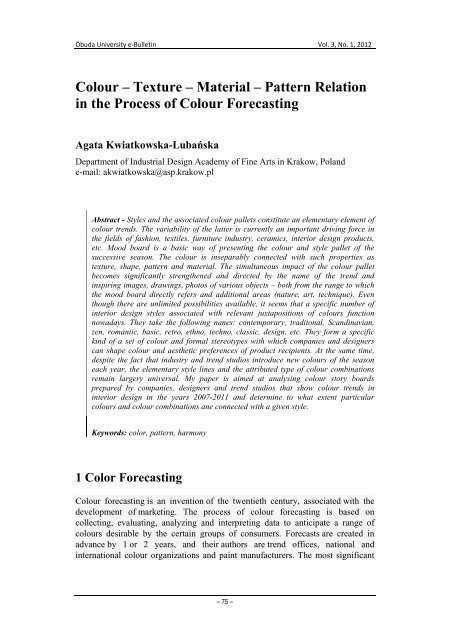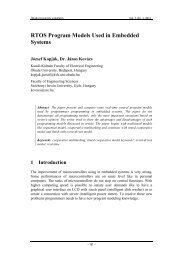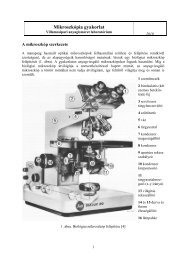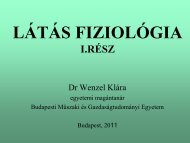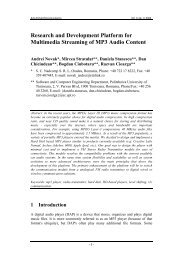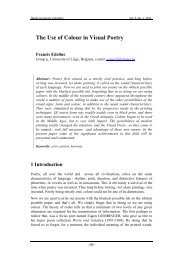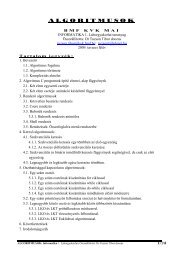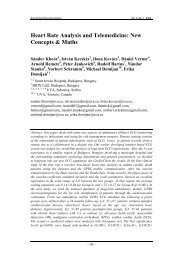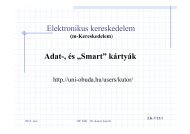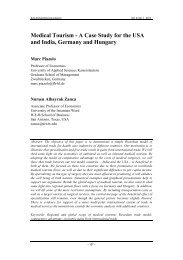Colour – Texture – Material – Pattern Relation in the Process of ...
Colour – Texture – Material – Pattern Relation in the Process of ...
Colour – Texture – Material – Pattern Relation in the Process of ...
You also want an ePaper? Increase the reach of your titles
YUMPU automatically turns print PDFs into web optimized ePapers that Google loves.
Óbuda University e‐Bullet<strong>in</strong> Vol. 3, No. 1, 2012<br />
<strong>Colour</strong> <strong>–</strong> <strong>Texture</strong> <strong>–</strong> <strong>Material</strong> <strong>–</strong> <strong>Pattern</strong> <strong>Relation</strong><br />
<strong>in</strong> <strong>the</strong> <strong>Process</strong> <strong>of</strong> <strong>Colour</strong> Forecast<strong>in</strong>g<br />
Agata Kwiatkowska-Lubańska<br />
Department <strong>of</strong> Industrial Design Academy <strong>of</strong> F<strong>in</strong>e Arts <strong>in</strong> Krakow, Poland<br />
e-mail: akwiatkowska@asp.krakow.pl<br />
Abstract - Styles and <strong>the</strong> associated colour pallets constitute an elementary element <strong>of</strong><br />
colour trends. The variability <strong>of</strong> <strong>the</strong> latter is currently an important driv<strong>in</strong>g force <strong>in</strong><br />
<strong>the</strong> fields <strong>of</strong> fashion, textiles, furniture <strong>in</strong>dustry, ceramics, <strong>in</strong>terior design products,<br />
etc. Mood board is a basic way <strong>of</strong> present<strong>in</strong>g <strong>the</strong> colour and style pallet <strong>of</strong> <strong>the</strong><br />
successive season. The colour is <strong>in</strong>separably connected with such properties as<br />
texture, shape, pattern and material. The simultaneous impact <strong>of</strong> <strong>the</strong> colour pallet<br />
becomes significantly streng<strong>the</strong>ned and directed by <strong>the</strong> name <strong>of</strong> <strong>the</strong> trend and<br />
<strong>in</strong>spir<strong>in</strong>g images, draw<strong>in</strong>gs, photos <strong>of</strong> various objects <strong>–</strong> both from <strong>the</strong> range to which<br />
<strong>the</strong> mood board directly refers and additional areas (nature, art, technique). Even<br />
though <strong>the</strong>re are unlimited possibilities available, it seems that a specific number <strong>of</strong><br />
<strong>in</strong>terior design styles associated with relevant juxtapositions <strong>of</strong> colours function<br />
nowadays. They take <strong>the</strong> follow<strong>in</strong>g nanes: contemporary, traditonal, Scand<strong>in</strong>avian,<br />
zen, romantic, basic, retro, ethno, techno, classic, design, etc. They form a specific<br />
k<strong>in</strong>d <strong>of</strong> a set <strong>of</strong> colour and formal stereotypes with which companies and designers<br />
can shape colour and aes<strong>the</strong>tic preferences <strong>of</strong> product recipients. At <strong>the</strong> same time,<br />
despite <strong>the</strong> fact that <strong>in</strong>dustry and trend studios <strong>in</strong>troduce new colours <strong>of</strong> <strong>the</strong> season<br />
each year, <strong>the</strong> elementary style l<strong>in</strong>es and <strong>the</strong> attributed type <strong>of</strong> colour comb<strong>in</strong>ations<br />
rema<strong>in</strong> largery universal. My paper is aimed at analys<strong>in</strong>g colour story boards<br />
prepared by companies, designers and trend studios that show colour trends <strong>in</strong><br />
<strong>in</strong>terior design <strong>in</strong> <strong>the</strong> years 2007-2011 and determ<strong>in</strong>e to what extent particular<br />
colours and colour comb<strong>in</strong>ations ane connected with a given style.<br />
Keywords: color, pattern, harmony<br />
1 Color Forecast<strong>in</strong>g<br />
<strong>Colour</strong> forecast<strong>in</strong>g is an <strong>in</strong>vention <strong>of</strong> <strong>the</strong> twentieth century, associated with <strong>the</strong><br />
development <strong>of</strong> market<strong>in</strong>g. The process <strong>of</strong> colour forecast<strong>in</strong>g is based on<br />
collect<strong>in</strong>g, evaluat<strong>in</strong>g, analyz<strong>in</strong>g and <strong>in</strong>terpret<strong>in</strong>g data to anticipate a range <strong>of</strong><br />
colours desirable by <strong>the</strong> certa<strong>in</strong> groups <strong>of</strong> consumers. Forecasts are created <strong>in</strong><br />
advance by 1 or 2 years, and <strong>the</strong>ir authors are trend <strong>of</strong>fices, national and<br />
<strong>in</strong>ternational colour organizations and pa<strong>in</strong>t manufacturers. The most significant<br />
<strong>–</strong> 75 <strong>–</strong>
A. Kwiatkowska‐Lubańska <strong>Colour</strong> <strong>–</strong> texture <strong>–</strong> material <strong>–</strong> pattern relation<br />
<strong>in</strong> <strong>the</strong> process <strong>of</strong> colour forecast<strong>in</strong>g<br />
are: <strong>the</strong> Color Association <strong>of</strong> <strong>the</strong> United States, <strong>the</strong> <strong>Colour</strong> Market<strong>in</strong>g Group, <strong>the</strong><br />
International <strong>Colour</strong> Authority, Panton Color Institute, <strong>the</strong> Trend Union, <strong>the</strong> Color<br />
Box, Perclers, Promostyl, Carl<strong>in</strong> International. At present <strong>the</strong> accuracy <strong>of</strong> <strong>the</strong><br />
forecasters <strong>in</strong>spires great confidence, this is why designers and market<strong>in</strong>g<br />
pr<strong>of</strong>essionals appear less sure <strong>of</strong> <strong>the</strong>ir own judgments and feel safer follow<strong>in</strong>g <strong>the</strong><br />
promoted trends. The <strong>in</strong>fluence <strong>of</strong> <strong>the</strong> forecasters on <strong>in</strong>dustry is thought by some<br />
to be highlighted by <strong>the</strong> power <strong>of</strong> promotion and advertis<strong>in</strong>g. But because so many<br />
colour designers work<strong>in</strong>g for <strong>the</strong> <strong>in</strong>dustry are <strong>in</strong>volved <strong>in</strong> colour<br />
forecast<strong>in</strong>g organizations, predictions made by <strong>the</strong>m can be treated as selffulfill<strong>in</strong>g<br />
[1]. The <strong>in</strong>formation collected by color forecasters is compiled <strong>in</strong>to<br />
trend prediction, develop<strong>in</strong>g colour stories, <strong>in</strong> which colour is is <strong>in</strong>separably<br />
connected with such properties as texture, shape, pattern and material. The<br />
simultaneous impact <strong>of</strong> <strong>the</strong> colour pallet becomes significantly streng<strong>the</strong>ned and<br />
directed by <strong>the</strong> name <strong>of</strong> <strong>the</strong> trend and <strong>in</strong>spir<strong>in</strong>g images, draw<strong>in</strong>gs, photos <strong>of</strong><br />
various objects <strong>–</strong> both from <strong>the</strong> range to which <strong>the</strong> mood board directly refers and<br />
additional areas (nature, art, technique). <strong>Colour</strong> stories are usually dedicated to a<br />
specific group <strong>of</strong> consumers, whose philosophy, lifestyle, preferences<br />
are determ<strong>in</strong>ed by market segmentation.<br />
Interior design is an area where <strong>the</strong> colour forecast<strong>in</strong>g plays a crucial role. The<br />
pa<strong>in</strong>t manufacturers form <strong>the</strong>ir own teams <strong>of</strong> colour experts from <strong>the</strong> fields <strong>of</strong><br />
design, architecture and fashion who annually meet to create <strong>the</strong>ir colour and<br />
lifestyle trends for <strong>the</strong> next season. Included <strong>in</strong> <strong>the</strong>se forecasts are not<br />
only color comb<strong>in</strong>ations but also o<strong>the</strong>r important features <strong>in</strong> <strong>the</strong> <strong>in</strong>terior<br />
design such as materials, styles, types <strong>of</strong> furniture, technology, textures and<br />
patterns [2].<br />
Although <strong>the</strong> color stories have different names one can extract a few lead<strong>in</strong>g<br />
trends. They usually have a reference to <strong>the</strong> styles function<strong>in</strong>g <strong>in</strong> <strong>the</strong> <strong>in</strong>terior<br />
decoration, colour traditions <strong>of</strong> <strong>in</strong>dividual countries or styles <strong>in</strong> architecture and<br />
art. The most common types <strong>of</strong> <strong>in</strong>terior trends are: m<strong>in</strong>imalist, rustic, <strong>in</strong>dustrial,<br />
retro, contemporary, English, French, Swedish (Gustavian), Mexican,<br />
Mediterranean, Tuscan, Art Deco, Pop Art, fifties, sixties, seventies, eighties. Any<br />
type <strong>of</strong> <strong>in</strong>terior trends corresponds to a specific palette <strong>of</strong> colors, materials, and a<br />
particular style <strong>of</strong> .furniture. They constitute a k<strong>in</strong>d <strong>of</strong> language used by <strong>in</strong>terior<br />
decorators. The versatile styles are <strong>in</strong> turn reflected <strong>in</strong> <strong>the</strong> trends<br />
annually produced by pa<strong>in</strong>t manufacturers. They also form <strong>the</strong> long term trend<br />
<strong>of</strong> color, and are repeated <strong>in</strong> <strong>the</strong> key styles and colors that are characteristic for a<br />
longer period <strong>of</strong> time (3-7 years) be<strong>in</strong>g at <strong>the</strong> same time a reflection <strong>of</strong><br />
current market developments, political, economic, cultural and social issues. At<br />
<strong>the</strong> same time colours and colour comb<strong>in</strong>ations used <strong>in</strong> <strong>the</strong> trends take on special<br />
mean<strong>in</strong>g and character, which sometimes is not <strong>in</strong>cluded <strong>in</strong> <strong>the</strong>ir more<br />
universal symbolism.<br />
<strong>–</strong> 76 <strong>–</strong>
Óbuda University e‐Bullet<strong>in</strong> Vol. 3, No. 1, 2012<br />
2 The Analysis <strong>of</strong> Selected Color Stories<br />
In my work, I collected 59 colour stories developed by pa<strong>in</strong>t manufacturers (ICI<br />
Pa<strong>in</strong>ts, Benjam<strong>in</strong> Moore, PPG, Sherw<strong>in</strong> Williams, Tikkurila) <strong>in</strong> 2007-2012. I have<br />
made a comparison <strong>of</strong> <strong>the</strong> colour stories <strong>in</strong> terms <strong>of</strong> <strong>the</strong> lead<strong>in</strong>g <strong>the</strong>me, <strong>in</strong>spiration,<br />
materials, design and style. I kept <strong>the</strong> record <strong>of</strong> colours <strong>in</strong> <strong>the</strong> colour systems used<br />
by <strong>in</strong>dividual companies. An important factor was also an associat<strong>in</strong>g <strong>the</strong> colour<br />
comb<strong>in</strong>ation with specific style, material, pattern and texture. In <strong>the</strong> presented<br />
colour comb<strong>in</strong>ations, <strong>the</strong>re is a different number <strong>of</strong> colours, rang<strong>in</strong>g from 4 <strong>–</strong> <strong>in</strong><br />
Tikkurila colour trends up to 17 <strong>in</strong> ICI Pa<strong>in</strong>ts <strong>Colour</strong> Futures. Some <strong>of</strong> <strong>the</strong> trends<br />
<strong>in</strong>clude a lot <strong>of</strong> <strong>in</strong>spirational photographs, o<strong>the</strong>rs are limited to <strong>the</strong> images <strong>of</strong> <strong>the</strong><br />
<strong>in</strong>teriors.<br />
The study analyzed <strong>the</strong> follow<strong>in</strong>g color stories:<br />
Akzo Nobel: grow<strong>in</strong>g respect (2008), explorer (2008), art form (2008), hidden<br />
beauty (2008), ecotecture (2009), white dimensions (2009), liv<strong>in</strong>g legacy (2009),<br />
equilibrium (2009), play house (2009), silent space (2010), fluid fantasy (2010),<br />
basic beliefs (2010), free spirit (2010), <strong>the</strong> beauty <strong>of</strong> everyday life (2011), f<strong>in</strong>d<strong>in</strong>g<br />
<strong>the</strong> way (2011), pop up pleasure (2011), made with love (2011), molecular magic<br />
(2011), delicate mix (2012), one small seed (2012), liv<strong>in</strong>g scrapbook (2012),<br />
different worlds (2012), rediscovered heroes (2012)<br />
Benjam<strong>in</strong> Moore: earth and sky (2012), eclectic elegance (2012), spiced life<br />
(2012), sense and sensibility (2012), dreamy (2011), spirited (2011), soulful<br />
(2011)<br />
PPG: ecotechno (2008), v<strong>in</strong>tage (2008), fair trade (2008), ecoloco (2008),<br />
wonderland (2009), avatar (2009), desert spice (2009), Indie (2009), upcycle<br />
(2011), new bohemia (2011), glamour (2011), <strong>in</strong>st<strong>in</strong>ct (2011), local revival<br />
(2012), beauty queen (2012), deco candy (2012), quiet tech (2012)<br />
Sherw<strong>in</strong> Williams: refreshed (2010), rooted (2010), simplified (2010), treasured<br />
(2010), bold <strong>in</strong>vention (2011), gentle medley (2011), purely ref<strong>in</strong>ed (2011),<br />
restless nomad (2011)<br />
Tikkurila: eco-rebellion (2012-2013), m<strong>in</strong>i romance (2012-2013), Antwerp<br />
(2012-2013), roots (2012-2013), open sea (2012-2013)<br />
In <strong>the</strong> Table I, I presented a comparison <strong>of</strong> selected n<strong>in</strong>e colour stories developed<br />
by ICI Pa<strong>in</strong>ts colour experts team and <strong>the</strong> ideas and lifestyles that are associated<br />
with <strong>the</strong> colour stories. Illustrations <strong>of</strong> all <strong>the</strong> colour palettes that have been<br />
subjected to analysis is presented <strong>in</strong> <strong>the</strong> TABLE II.<br />
<strong>–</strong> 77 <strong>–</strong>
A. Kwiatkowska‐Lubańska <strong>Colour</strong> <strong>–</strong> texture <strong>–</strong> material <strong>–</strong> pattern relation<br />
<strong>in</strong> <strong>the</strong> process <strong>of</strong> colour forecast<strong>in</strong>g<br />
TABLE I. Selected colour trends characteristics (ICI Pa<strong>in</strong>ts <strong>–</strong> 2008-2009)<br />
<strong>Colour</strong> <strong>the</strong>me General idea<br />
<strong>Material</strong>s Style <strong>Colour</strong>s<br />
and key words<br />
and patterns<br />
„Grow<strong>in</strong>g<br />
Respect”<br />
ICI Pa<strong>in</strong>ts<br />
2008 [3]<br />
“Ebb and flow”<br />
ICI Pa<strong>in</strong>ts<br />
2008 [3]<br />
Liv<strong>in</strong>g <strong>in</strong> more<br />
immediate touch with<br />
nature. Susta<strong>in</strong>able,<br />
botanical, supportive,<br />
natural, responsible.<br />
A futuristic vision <strong>of</strong><br />
form and material.<br />
Fluid, translucent,<br />
complex,<br />
contemporary,<br />
<strong>in</strong>novative,<br />
imag<strong>in</strong>ative.<br />
Susta<strong>in</strong>able<br />
materials,<br />
recyclable staff,<br />
wood, straw,<br />
rattan,<br />
enamelware,<br />
bamboo,<br />
cardboard. Pla<strong>in</strong><br />
colors, irregular<br />
surfaces.<br />
New, syn<strong>the</strong>tic<br />
materials, rapid<br />
prototyp<strong>in</strong>g,<br />
transparent,<br />
liquid,<br />
translucent<br />
plastics.<br />
Underwater<br />
pattern textiles.<br />
<strong>–</strong> 78 <strong>–</strong><br />
A mix and match<br />
approach,<br />
Flexible and<br />
adaptable products,<br />
recycl<strong>in</strong>g, reus<strong>in</strong>g.<br />
Creative product<br />
developments <strong>in</strong><br />
glass, light<strong>in</strong>g,<br />
textiles and plastics<br />
<strong>–</strong> <strong>the</strong> undulat<strong>in</strong>g,<br />
organic forms.<br />
40 YY 77/242,<br />
30 YR 14/365,<br />
50 BG 44/094,<br />
70 YY 73/288,<br />
70 YY 59/485,<br />
40 YY 34/446,<br />
40 YY 64/165,<br />
43 YY 81/051,<br />
90 YR 25/323,<br />
20 YY 53/423,<br />
50 YR 10/151,<br />
10 GY 40/296,<br />
50GY 18/178<br />
Color<br />
description:<br />
mid-tones <strong>of</strong><br />
bark, shale,<br />
rust and<br />
mustard with<br />
paler botanical<br />
shades <strong>of</strong><br />
pollen, apple<br />
and moss.<br />
30 YY 72/018,<br />
80 YR 65/185,<br />
99 YR 82/029,<br />
30 BB 18/190,<br />
10 BB 07/150,<br />
90 BG 72/063,<br />
90 GG 73/062,<br />
10 BB 83/014,<br />
10 BG 54/199,<br />
70 BG 70/113,<br />
90 BG 38/185,<br />
30 YY 71/073,<br />
90 YY 67/117,<br />
70 GY 63/098,<br />
50 BG 32/114,<br />
50 BG 12/219<br />
Color<br />
description:<br />
aqueous pales<br />
and mid-tones<br />
contrasted by<br />
subtle dappled<br />
deeps and<br />
touches <strong>of</strong><br />
light-reflect<strong>in</strong>g<br />
clarity.
Óbuda University e‐Bullet<strong>in</strong> Vol. 3, No. 1, 2012<br />
“Art form”<br />
ICI Pa<strong>in</strong>ts<br />
2008 [3]<br />
“Hidden beauty”<br />
ICI Pa<strong>in</strong>ts<br />
2008 [3]<br />
“Explorer”<br />
ICI Pa<strong>in</strong>ts<br />
2008 [3]<br />
A simplicity <strong>of</strong> form,<br />
and functionality.<br />
Urban, “sleek, chic and<br />
cool”, streaml<strong>in</strong>ed,<br />
cerebral, sophisticated,<br />
graphic.<br />
A connection <strong>of</strong><br />
mascul<strong>in</strong>e materials<br />
and fem<strong>in</strong><strong>in</strong>e forms.<br />
Sculpted, sensual,<br />
ornamental, ref<strong>in</strong>ed,<br />
exotic, subtle.<br />
Geographical, spiritual<br />
or cultural journey.<br />
Enrich<strong>in</strong>g, eclectic,<br />
rhythmic, hybrid,<br />
youthful, diverse.<br />
Concrete, steel,<br />
alum<strong>in</strong>um, glass,<br />
pla<strong>in</strong> colors or<br />
bold geometrical<br />
patterns.<br />
Sheer fabrics,<br />
ceramics with<br />
embossed<br />
decoration,<br />
objects that are<br />
wrapped <strong>in</strong><br />
stretch.<br />
Mixture <strong>of</strong><br />
materials plastics<br />
and natural,<br />
hybrid nature <strong>of</strong><br />
<strong>the</strong> palette.<br />
<strong>–</strong> 79 <strong>–</strong><br />
Modern furniture,<br />
colour block<strong>in</strong>g,<br />
m<strong>in</strong>imalist<br />
<strong>in</strong>teriors, <strong>the</strong><br />
reoccupation <strong>of</strong> <strong>the</strong><br />
disused <strong>in</strong>dustrial<br />
zones.<br />
A sensual and<br />
<strong>in</strong>trigu<strong>in</strong>g look.<br />
Designs by Karim<br />
Rashid, Zaha<br />
Hadid, Arik Levy<br />
and Hasan Fathy.<br />
Traditional crafts<br />
developed <strong>in</strong>to new<br />
design by designers<br />
us<strong>in</strong>g basic and<br />
<strong>of</strong>ten cheap<br />
60 YY 71/409,<br />
30 YY 68/024,<br />
40 YY 63/473,<br />
00NN 37/000,<br />
30 YY 20/193,<br />
00NN 62/000,<br />
71 YY 87/078,<br />
40 YY 67/087,<br />
40 YY 49/408,<br />
70 YY 66/265,<br />
20 YY 53/124,<br />
70 YY 55/299,<br />
30 YY 10/038,<br />
10 YY 35/094,<br />
90 BG 16/060,<br />
72 BG 75/023:<br />
Color<br />
description:<br />
warm, dusty<br />
greys, yellows<br />
<strong>–</strong> lemon,<br />
mustard and<br />
mimosa.<br />
50 RR 11/286,<br />
90 YR 36/203,<br />
50 YR 18/223,<br />
00YY 76/088,<br />
30YR 49/097,<br />
90 YR 67/085,<br />
80 YR44/101,<br />
10YY 72/172,<br />
60 YR 40/297,<br />
90RR 16/095,<br />
10 YR 27/323,<br />
10YR 13/437,<br />
96 RR 08/311,<br />
43YY 78/053,<br />
70 RR 07/100<br />
Color<br />
description:<br />
sk<strong>in</strong> tones,<br />
nude p<strong>in</strong>ks,<br />
desert reds,<br />
brick, corals,<br />
delicate<br />
shades <strong>of</strong><br />
sand, pearl,<br />
chiffon and<br />
shell.<br />
40 YY 63/473,<br />
90 YY 48/500,<br />
80 YR 34/468,<br />
30 YY 64/149,<br />
90 GG 30/195,
A. Kwiatkowska‐Lubańska <strong>Colour</strong> <strong>–</strong> texture <strong>–</strong> material <strong>–</strong> pattern relation<br />
<strong>in</strong> <strong>the</strong> process <strong>of</strong> colour forecast<strong>in</strong>g<br />
“Eco tecture”<br />
ICI Pa<strong>in</strong>ts<br />
2009 [4]<br />
“White<br />
dimensions”<br />
ICI Pa<strong>in</strong>ts<br />
2009 [4]<br />
Green energy, global<br />
citizenship. Faceted,<br />
futuristic, syn<strong>the</strong>tic,<br />
<strong>in</strong>trigu<strong>in</strong>g, complex,<br />
eng<strong>in</strong>eered, poetic and<br />
magical.<br />
A touch <strong>of</strong> modern<br />
magic. A new 21 st<br />
century dawn <strong>of</strong> s<strong>of</strong>t<br />
white.<br />
Faceted, futuristic,<br />
syn<strong>the</strong>tic, <strong>in</strong>trigu<strong>in</strong>g,<br />
complex, eng<strong>in</strong>eered,<br />
Susta<strong>in</strong>able<br />
materials,<br />
recyclable staff,<br />
playwood.<br />
A highly<br />
eng<strong>in</strong>eered<br />
materials and<br />
constructions,<br />
Sculptured and<br />
geometric<br />
surfaces, layered<br />
and organic,<br />
<strong>–</strong> 80 <strong>–</strong><br />
materials.<br />
Designers like:<br />
Patricia Urquiola,<br />
Campana bro<strong>the</strong>rs,<br />
Paola Lenti.<br />
Ultra high<br />
technology systems<br />
(Hearst Tower <strong>in</strong><br />
New York City)<br />
Hi-tech materials<br />
and rapid<br />
prototyp<strong>in</strong>g .<br />
Cutt<strong>in</strong>g edge<br />
designers such as:<br />
Tord Boontje,<br />
Marcel Wanders,<br />
Ron Arad, Droog<br />
10 YY 46/515,<br />
29 YY 84/067,<br />
14 YR 10/434,<br />
80 RR 67/260,<br />
70 BB 65/066,<br />
90 RR 28/245,<br />
10 RB 21/218,<br />
90 RR 08/129,<br />
56 RB 09/302,<br />
50 BB 11/321<br />
Color<br />
description:<br />
multi-colour<br />
pallet with<br />
brick red,<br />
yellow,<br />
electric blue,<br />
orange, violet<br />
and grass<br />
green.<br />
40 YY 44/408,<br />
30 YY 58/178,<br />
70 YY 72/041,<br />
90 GG 30/195,<br />
20 YY 57/060,<br />
30 RR 30/103,<br />
70 YY 55/613,<br />
70 YY 25/200,<br />
70 BB 55/044,<br />
70 BB 15/081,<br />
10 BB 17/269,<br />
10 GG 51/125,<br />
30 YY 14/070,<br />
20 YY 39/130,<br />
10 GY 40/296,<br />
70 GG 13/323<br />
Color<br />
description:<br />
s<strong>of</strong>t, natural<br />
colours such<br />
as straw, olive<br />
willow and<br />
aqua enliven<br />
by techno<br />
greens, mar<strong>in</strong>e<br />
blue and<br />
mauve.<br />
00NN 72/000,<br />
00NN 83/000,<br />
30 YY 71/073,<br />
70 YR 68/102,<br />
10 YY 44/215,<br />
70 YR 45/261,<br />
50 YR 23/365,<br />
44 YY 84/042,
Óbuda University e‐Bullet<strong>in</strong> Vol. 3, No. 1, 2012<br />
“Liv<strong>in</strong>g legacy”<br />
ICI Pa<strong>in</strong>ts<br />
2009 [4]<br />
“Equilibrium”<br />
ICI Pa<strong>in</strong>ts<br />
2009 [4]<br />
poetic and magical faceted and<br />
filtered.<br />
New es<strong>the</strong>tic approach<br />
to design and craft,<br />
micro production and<br />
limited editions.<br />
Cont<strong>in</strong>uity, <strong>in</strong>tegrity,<br />
pride, rediscovery,<br />
genu<strong>in</strong>e customization<br />
New attitude to life and<br />
leisure, re-evaluat<strong>in</strong>g<br />
human relationships.<br />
Nurtur<strong>in</strong>g, refresh<strong>in</strong>g,<br />
balanced, susta<strong>in</strong><strong>in</strong>g,<br />
heal<strong>in</strong>g<br />
Metal, textile<br />
ceramic, glass or<br />
wood, unique<br />
and valued craft<br />
skills<br />
Natural materials<br />
such as bamboo,<br />
timber framed<br />
carpentry, and<br />
dark metals such<br />
as iron, and rock.<br />
<strong>–</strong> 81 <strong>–</strong><br />
and Moooi. 10 YR 40/054,<br />
60 YR 73/015,<br />
10 GG 72/022,<br />
10 BB 40/090,<br />
98 YR 78/041,<br />
50 GG 55/049,<br />
70 BG 07/086,<br />
30 YY 22/059<br />
Color<br />
description:<br />
s<strong>of</strong>t and<br />
chalky whites<br />
with muted<br />
and subtle<br />
shadowy<br />
shades <strong>of</strong>fset<br />
by <strong>the</strong> stronger<br />
colours <strong>of</strong><br />
rust, clay and<br />
dark slate.<br />
Objects are unique<br />
<strong>–</strong> <strong>the</strong>y flaunt and<br />
celebrate <strong>the</strong>ir<br />
workmanship,<br />
construction and<br />
materials, whe<strong>the</strong>r<br />
made <strong>of</strong> metal,<br />
ceramic, glass or<br />
wood, <strong>the</strong>y <strong>of</strong>ten<br />
come from <strong>the</strong><br />
worlds develop<strong>in</strong>g<br />
countries and<br />
regions, made by<br />
local craftsmen.<br />
Japanese <strong>in</strong>spired<br />
<strong>in</strong>teriors, Zen-like<br />
qualities <strong>of</strong> space,<br />
open floor plans.<br />
30 YR 25/463,<br />
30 YR 07/157,<br />
50 YR 23/365,<br />
00YY 19/261,<br />
10 RR 24/061,<br />
70 YR 45/261,<br />
30 YR 31/154,<br />
20 YY 57/060,<br />
70 RR 16/116,<br />
44 YY 70/110,<br />
30 YY 49/562,<br />
70 BG 56/061,<br />
30 YY 38/370,<br />
60 YY 67/251,<br />
30 BB 10/112,<br />
23 YR 10/308<br />
Color<br />
description:<br />
rich and varied<br />
range <strong>of</strong><br />
botanical<br />
shades such as<br />
mustard, aloe,<br />
grape and<br />
cactus,<br />
enlivened by<br />
techno tone <strong>of</strong><br />
lemon green.<br />
60 YY 33/130,<br />
70 YY 65/090,<br />
50 GY 66/111,<br />
90 YY 62/264,<br />
60 YY 67/251,<br />
10 YY 61/136,<br />
80 YR 40/148,
A. Kwiatkowska‐Lubańska <strong>Colour</strong> <strong>–</strong> texture <strong>–</strong> material <strong>–</strong> pattern relation<br />
<strong>in</strong> <strong>the</strong> process <strong>of</strong> colour forecast<strong>in</strong>g<br />
“Play house”<br />
ICI Pa<strong>in</strong>ts<br />
2009 [4]<br />
Putt<strong>in</strong>g <strong>the</strong> fun <strong>in</strong>to<br />
functionality, mak<strong>in</strong>g<br />
home an amus<strong>in</strong>g place<br />
to be<br />
Plastics,<br />
syn<strong>the</strong>tic<br />
materials,<br />
transparent,<br />
opaque,<br />
translucent.<br />
<strong>–</strong> 82 <strong>–</strong><br />
<strong>Colour</strong> block<strong>in</strong>g,<br />
affordable and easy<br />
to change, amus<strong>in</strong>g<br />
everyday objects.<br />
80 YR 17/129,<br />
10 YR 10/101,<br />
00 YY 83/046,<br />
50 YR 68/114,<br />
80 YR 67/085,<br />
30 YY 80/088,<br />
90 YR 51/109,<br />
10 YY 60/224,<br />
00 YY 43/304<br />
Color<br />
description:<br />
<strong>the</strong> palette is<br />
<strong>in</strong>spired by <strong>the</strong><br />
tones <strong>of</strong> sk<strong>in</strong><br />
and tea like<br />
jasm<strong>in</strong>e, rose<br />
and l<strong>in</strong>den,<br />
moss and<br />
m<strong>in</strong>t.<br />
30 BB 16/031,<br />
30 YY 72/018,<br />
90 YY 48/500,<br />
50 BG 55/241,<br />
70 GG 39/303,<br />
10 BG 14/296,<br />
70 YY 12/167,<br />
70 YY 46/160,<br />
70 YY 63/326,<br />
50 YY 65/454,<br />
08 YY 56/528,<br />
25 YR 34/473,<br />
30 YY 47/145,<br />
30 YR 53/188,<br />
30 RR 15/375,<br />
04 YR 11/537<br />
Color<br />
description:<br />
vibrant,<br />
saturated<br />
shades such as<br />
coral,<br />
grapefruit,<br />
kiwi and<br />
fuchsia, <strong>of</strong>fset<br />
by s<strong>of</strong>ter and<br />
more degraded<br />
ones like<br />
graphite, ecru<br />
and khaki.
Óbuda University e‐Bullet<strong>in</strong> Vol. 3, No. 1, 2012<br />
3 An Analysis <strong>of</strong> <strong>the</strong> Collected <strong>Colour</strong> Stories<br />
In <strong>the</strong> analysis <strong>of</strong> <strong>the</strong> selected color stories a method used was Shigenibu<br />
Kobayashi Color <strong>–</strong> image <strong>–</strong> scale. The stories were grouped toge<strong>the</strong>r <strong>in</strong>to <strong>the</strong> 13<br />
categories (see Tab. II) and separated <strong>in</strong> <strong>the</strong> Color Comb<strong>in</strong>ation Image Scale as:<br />
casual, pretty, dynamic, romantic, natural, elegant, gorgeous, classic, clear, cool<br />
casual, chic, dandy, modern. Alas <strong>the</strong> cited categories were not fully responsive to<br />
<strong>the</strong> <strong>in</strong>terior colour comb<strong>in</strong>ations. Therefore I attempted to group <strong>the</strong> colour<br />
palettes <strong>in</strong> specific 14 styles, popular <strong>in</strong> <strong>in</strong>terior design. They are largely <strong>in</strong><br />
l<strong>in</strong>e with <strong>the</strong> boundaries proposed by Kobayashi, although <strong>the</strong>y represent only a<br />
portion <strong>of</strong> <strong>the</strong> styles used <strong>in</strong> <strong>in</strong>terior design and <strong>the</strong>y result directly from <strong>the</strong><br />
analysis <strong>of</strong> collected colour palettes examples. With<strong>in</strong> this overall system, colour<br />
comb<strong>in</strong>ations that resemble each o<strong>the</strong>r are grouped toge<strong>the</strong>r <strong>in</strong>to categories, such<br />
as modern m<strong>in</strong>imalism or shabby chic, so that each colour comb<strong>in</strong>ation’s<br />
dist<strong>in</strong>guish<strong>in</strong>g characteristics are easier to see, and <strong>the</strong>ir images can be<br />
differentiated with greater precision.<br />
The names <strong>of</strong> <strong>in</strong>terior styles do not apply only to colours, but can be equally<br />
applied to shapes, patterns, materials and overall <strong>in</strong>terior decoration.<br />
Modern M<strong>in</strong>imalist Style: White is <strong>the</strong> basic color for a m<strong>in</strong>imalist <strong>in</strong>terior<br />
design look, alternative to white are neutral colours, pale beige, taupe, stone. The<br />
ma<strong>in</strong> colour comb<strong>in</strong>ations are neutrals with white, accent colours are allowed. The<br />
emphasis is on simplicity, pieces <strong>of</strong> furniture are geometrical shapes <strong>–</strong> square,<br />
rectangular, round, <strong>the</strong> surfaces are clean, without patterns or details, textures are<br />
glossy. The f<strong>in</strong>ishes used are <strong>of</strong>ten <strong>of</strong> ultra-modern chrome, alum<strong>in</strong>um, sta<strong>in</strong>less<br />
steel or glass.<br />
Shabby Chic Style: Whites, creams and s<strong>of</strong>t pastels. The essence <strong>of</strong> shabby chic<br />
style is v<strong>in</strong>tage and antique furniture with <strong>the</strong> orig<strong>in</strong>al aged pa<strong>in</strong>t, or pa<strong>in</strong>ted white<br />
(or ano<strong>the</strong>r s<strong>of</strong>t pastel color) and distressed at <strong>the</strong> corners by sand<strong>in</strong>g.<br />
50’s Retro Style: Pastel colors that are particularly characteristic for <strong>the</strong> style are<br />
p<strong>in</strong>k, pale yellow, turquoise, m<strong>in</strong>t green and blue. Furniture Rang<strong>in</strong>g from<br />
Scand<strong>in</strong>avian lam<strong>in</strong>ated plywood furniture with very clean l<strong>in</strong>es to space age,<br />
plastic organic shapes. There is a liberal use <strong>of</strong> traditional material, such as wood,<br />
and non-traditional materials such as metal, glass, v<strong>in</strong>yl, plywood, Plexiglass and<br />
Lucite.<br />
<strong>–</strong> 83 <strong>–</strong>
A. Kwiatkowska‐Lubańska <strong>Colour</strong> <strong>–</strong> texture <strong>–</strong> material <strong>–</strong> pattern relation<br />
<strong>in</strong> <strong>the</strong> process <strong>of</strong> colour forecast<strong>in</strong>g<br />
TABLE II. <strong>Colour</strong> trends created by pa<strong>in</strong>t manufacturers <strong>the</strong> years 2008-2012<br />
<strong>–</strong> 84 <strong>–</strong>
Óbuda University e‐Bullet<strong>in</strong> Vol. 3, No. 1, 2012<br />
TABLE III. Shigenobu Kobayashi <strong>Colour</strong> Comb<strong>in</strong>ation Image Scale applied to <strong>in</strong>terior colour stories.<br />
Pop Art <strong>in</strong>spired Style: Vivid, clear and bright colors, with strong contrast <strong>of</strong><br />
hue. Contrast<strong>in</strong>g color comb<strong>in</strong>ations us<strong>in</strong>g many different hues. Images from<br />
popular culture and advertis<strong>in</strong>g. The use <strong>of</strong> new manufactur<strong>in</strong>g techniques and<br />
materials like plastic and arylic. An irreverent, not-so-serious, tongue-<strong>in</strong>-cheek<br />
aes<strong>the</strong>tic.<br />
Natural Style: Richness <strong>of</strong> natural materials, warm, simple, opposed to <strong>the</strong><br />
artificial feel<strong>in</strong>g <strong>of</strong> modern. Color comb<strong>in</strong>ations are rich, sometimes grayish<br />
without vivid, clear tones. There is no pure white or black. Style structure is a<br />
crude, rough details, structure elements <strong>of</strong> furniture / light<strong>in</strong>g can be <strong>in</strong> tree trunks,<br />
logs, branches, jute. Style is found <strong>in</strong> mounta<strong>in</strong> vacation homes, rural.<br />
Contemporary Style: Colors are balanced, warm and cold, bright and pastel<br />
tones. F<strong>in</strong>ishes warm, wood-veneer, solid wood doors with frames or appearance<br />
to look more polished and panels upholstered with lea<strong>the</strong>r or sometimes, may be<br />
characteristic <strong>of</strong> this style. Textile materials, lea<strong>the</strong>r, upholstered pieces are <strong>of</strong>ten<br />
used <strong>in</strong> shap<strong>in</strong>g <strong>the</strong> ambience characteristic <strong>of</strong> this style.<br />
Swedish (Gustavian) Style: Pale tones <strong>of</strong> white, cream, s<strong>of</strong>t yellow, pale p<strong>in</strong>k,<br />
s<strong>of</strong>t green, and dove gray. S<strong>in</strong>ce pale walls, floors, and furnish<strong>in</strong>gs reflect <strong>the</strong><br />
natural light, <strong>in</strong>teriors decorated with this style are cheerful, calm, and even warm<br />
even on <strong>the</strong> darkest w<strong>in</strong>ter days. After white, blue and red are <strong>the</strong> colors most<br />
<strong>of</strong>ten used <strong>in</strong> Swedish style <strong>in</strong>teriors, <strong>the</strong>y can be found <strong>in</strong> wallpaper, fabrics,<br />
<strong>–</strong> 85 <strong>–</strong>
A. Kwiatkowska‐Lubańska <strong>Colour</strong> <strong>–</strong> texture <strong>–</strong> material <strong>–</strong> pattern relation<br />
<strong>in</strong> <strong>the</strong> process <strong>of</strong> colour forecast<strong>in</strong>g<br />
stripes, and floral pr<strong>in</strong>ts. Light colored hard and s<strong>of</strong>t woods are used for case<br />
goods and floor<strong>in</strong>g. Birch, white p<strong>in</strong>e, beech, and alder are very common. Woods<br />
are <strong>of</strong>ten bleached, pa<strong>in</strong>ted or sta<strong>in</strong>ed with white or pale pa<strong>in</strong>ts.<br />
Eco Modern Style: <strong>Colour</strong>s <strong>in</strong>spired by nature, especially greens and blues <strong>–</strong><br />
ei<strong>the</strong>r muted or bright. Furniture from susta<strong>in</strong>able materials or recycled resources,<br />
with natural f<strong>in</strong>ishes. Textiles made from hemp, organic cotton, organic l<strong>in</strong>en, and<br />
tencel.<br />
High Tech Style: A lot <strong>of</strong> neutrals, <strong>the</strong> key color is grey. Vivid colors, giv<strong>in</strong>g an<br />
accent, are used to create a bold effect. Rough surfaces, unf<strong>in</strong>ished look and<br />
everyth<strong>in</strong>g related to <strong>in</strong>dustry, fabrics and such. Concrete, steel, metals that are<br />
embossed, brushed, pla<strong>in</strong> or pa<strong>in</strong>ted. Exposed pipes, ducts and beams. Floors<br />
surfaced with materials <strong>in</strong>dustrial <strong>in</strong> orig<strong>in</strong> - concrete, monochrome ceramic tile,<br />
v<strong>in</strong>yl tile (with raised rubber dots) or flat commercial-grade carpet<strong>in</strong>g.<br />
Global Fusion Style: The items tell <strong>the</strong> story <strong>of</strong> life and travel. Moroccan<br />
lanterns, African bowls and vases and Asian-<strong>in</strong>spired furniture blend seamlessly.<br />
Natural materials, warm colors, multicolor comb<strong>in</strong>ations.<br />
Glamour Style: Mature, extravagant, allur<strong>in</strong>g, luxurious. Red and mauve colors<br />
with black, white and gold. Furniture and accessories have time-worn elegance<br />
and a v<strong>in</strong>tage look. Chairs, tables, and armoires pa<strong>in</strong>ted <strong>in</strong> black or cream bear<br />
golden accents. They blend beautifully with dark, carved wood. Rich,<br />
shimmer<strong>in</strong>g silks and luxurious brocades and velvets enhance upscale <strong>in</strong>teriors.<br />
Classic Style: Traditional, elaborative, decorative and formal. The colors<br />
comb<strong>in</strong>ations are dark and hard. The contrasts are moderate. The use <strong>of</strong> brown,<br />
black and olive green gives a feel<strong>in</strong>g <strong>of</strong> tradition and quality. By add<strong>in</strong>g w<strong>in</strong>e and<br />
gold colors a feel<strong>in</strong>g <strong>of</strong> gorgeousness is created. The style is ref<strong>in</strong>ed, developed,<br />
rich <strong>in</strong> details, which are found both <strong>in</strong> <strong>the</strong> structure <strong>of</strong> furniture, light<strong>in</strong>g, etc. as<br />
well as <strong>in</strong> sets, pr<strong>in</strong>ts. The furniture is <strong>the</strong> “art” type, carved or <strong>in</strong>laid details and<br />
apply.<br />
Classic Style Re<strong>in</strong>terpreted: Classic forms are found <strong>in</strong> a new approach, some<br />
elements <strong>of</strong> a furniture style comb<strong>in</strong>ed with modern elements, creat<strong>in</strong>g that fusion<br />
between old and new. F<strong>in</strong>ish<strong>in</strong>g parts are <strong>in</strong> a new approach - pa<strong>in</strong>ted and<br />
varnished, with different and <strong>in</strong>novative <strong>of</strong>ten cold colors, surface gold, silver,<br />
f<strong>in</strong>ished with pat<strong>in</strong>a or serigraphic.<br />
Conclusions<br />
The analysis showed that <strong>the</strong>re are now well established <strong>in</strong>terior style categories<br />
that occur <strong>in</strong> developed annually by <strong>the</strong> pa<strong>in</strong>t manufacturers colour trends for <strong>the</strong><br />
com<strong>in</strong>g years. They are a k<strong>in</strong>d <strong>of</strong> a visual language <strong>in</strong> which colour comb<strong>in</strong>ations<br />
have a def<strong>in</strong>ed scope and features and <strong>the</strong>y are closely connected with such<br />
attributes as texture, pattern, material and shape. They are also very <strong>of</strong>ten<br />
associated with a particular lifestyle. In this way additional features and mean<strong>in</strong>gs<br />
<strong>–</strong> 86 <strong>–</strong>
Óbuda University e‐Bullet<strong>in</strong> Vol. 3, No. 1, 2012<br />
are ascribed to <strong>the</strong> colour comb<strong>in</strong>ation, which are clear only <strong>in</strong> <strong>the</strong> case <strong>of</strong><br />
apply<strong>in</strong>g it <strong>in</strong> <strong>the</strong> <strong>in</strong>terior <strong>of</strong> a specific style and character. The mean<strong>in</strong>g <strong>of</strong> <strong>the</strong>se<br />
has become very important for <strong>in</strong>terior designers and aes<strong>the</strong>tic evaluation is<br />
closely connected with <strong>the</strong> specific context <strong>of</strong> a colour comb<strong>in</strong>ation.<br />
References<br />
[l] T. Diane and T. Cassidy, "<strong>Colour</strong> Forecast<strong>in</strong>g", pp. 26-28.Blackwell<br />
Publish<strong>in</strong>g, 2005.<br />
[2] K. McCloud, “Choos<strong>in</strong>g <strong>Colour</strong>s”, , p. 40, Quadrille Publish<strong>in</strong>g Ltd, London<br />
2003.<br />
[3] Color Futures 2008, International <strong>Colour</strong> Trends, ICI Pa<strong>in</strong>ts, International<br />
Market<strong>in</strong>g Department, Berkshire, UK, 2008.<br />
[4] Color Futures 2009, International <strong>Colour</strong> Trends, Akzo Nobel Decorative<br />
Pa<strong>in</strong>ts, International Market<strong>in</strong>g Department, Berkshire, UK, 2009.<br />
[5] Sh. Kobayashi, “Color Image Scale”, pp. 17-20, .Kodansha International,<br />
Tokyo, New York, London 1990.<br />
<strong>–</strong> 87 <strong>–</strong>


